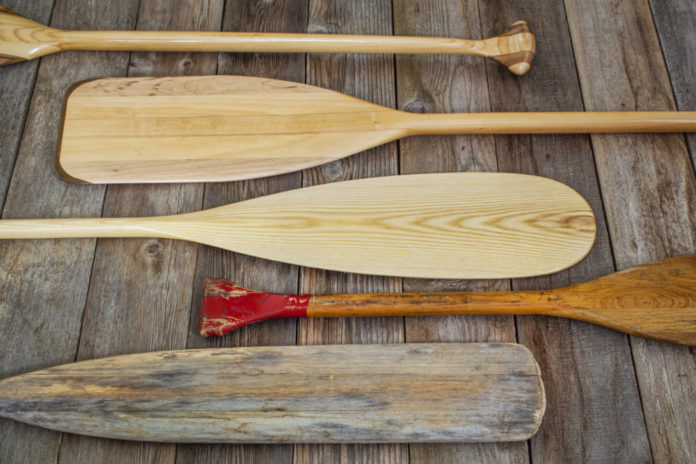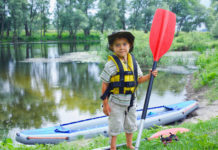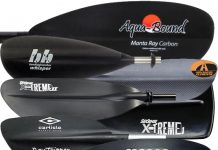
Before buying a canoe paddle – much like when you buy the boat itself – you first need to decide on what you want to do, where you’ll be paddling, and what your budget is.
If you can try a variety of paddle styles through borrowing a friend’s paddle, renting equipment, or demo days, you’ll understand how different characteristics affect performance. You’ll get to know the features, length, and material that you like the most and that best suit your needs.
But if you can’t try before you buy or you still want some guidance selecting a canoe paddle, our buyer's guide will keep you right. You’ll be sure to find the perfect paddle from our roundup of the best canoe paddles on the market.
Our reviews are honest and cut the BS. Many outfitters will push you in the direction of $100 paddles claiming that spending anything less is wasted money. I disagree. While I have no doubt these fine works of art handle superbly, most canoers simply don’t need anything as extravagant. Our recommendations are practical, and won’t break the bank.
Let’s begin by looking at the key features you should be paying attention to when choosing your paddle.
Our Top 5 Best Canoe Paddles
Product | Weight | Lengths (inch) | Material | Price | Our Rating |
|---|---|---|---|---|---|
22 oz | 48, 50, 54 | Wood | $$$ | ||
24 oz | 42 - 72 | Wood | $ | ||
30 oz | 54, 57, 60, 63 | Wood | $$ | ||
??? | 54, 60 | alu / plastic | $ | ||
34 oz | 51 - 66 | alu / plastic | $ |
Scroll down to see full reviews!
Length
It’s common practice to pick a paddle length based on your height. And as a rough benchmark, any paddle that is between your sternum and nose when you’re standing is probably going to fit.
However, if you want an optimal fit, you have to consider a range of factors:
- The environment and conditions
- Depth of water and blade length
- The height of the canoe seat
- The paddler’s arm length
- Whether you’re a bow or stern paddler; bow paddlers may want a shorter paddle, and stern paddlers may want a longer one.
Taking all the above points into consideration is the only way to size a canoe paddle properly. But unless you’re buying your canoe and paddle at the same time and know the waters you’ll be paddling, such a precise method is unlikely. So, in most cases, deciding on paddle length based on your height or manufacturer sizing charts will achieve a reasonable fit.
Material
Canoe paddles are constructed from wood, plastic, aluminium, carbon fibre, or a mix of these materials. Each material comes with pros and cons which we’ll cover below:
Wood
Wooden paddles look much more attractive and also come in a wider variety of styles. They can be a single piece of timber or multiple pieces glued together.
I prefer wooden paddles as they have a nice feel and provide good sensation, letting you know what’s going on below the surface. They’re also warmer and more comfortable to hold, making them ideal for long-distance paddling.
Their downside is that they require maintenance and you will need to check the laminate isn’t breached after each paddle.
Plastic and Aluminium
Plastic and aluminium combine to make economic paddles of reasonable quality. The blade and handle are often made from plastic and the shaft from aluminium – which can be unbearably stingy on your control hand on cold days.
These paddles are the cheapest of the bunch, and they’re also lightweight and don’t rust. However, they tend to come in a single style that may not suit your needs.
Carbon
Carbon fibre paddles are strong and durable and are warmer to the touch than aluminium. Carbon also has good strength to weight ratios, and carbon paddles are much lighter and easier to use.
They are stiff enough for powerful strokes, but also have enough give to remain comfortable. You’ll often find them in bent shaft models as they make good touring paddles. However, for advanced materials that have the benefit of being light, you’re going to have to pay a little more.
Shaft Design
In addition to construction material, the shape of the shaft and blade angle also influence the feel and performance of the paddle. Shafts come in straight and bent models.
Straight shafts are suitable for novice or intermediate paddlers, or those that are only going to be out on the water for an afternoon. They’re beginner friendly, and little thought has to be given to blade entry or movement through the water.
If you’re going to be touring and camping, and you’re likely to be on the water for weeks or months at a time, then go with a bent shaft. Having a bend at the throat (where the shaft joins the blade) results in the blade being perpendicular to the water at the most powerful part of the stroke. Bent shafts ensure maximum efficiency and the increase in power is noticeable.
Some paddles will have a double bend - one further up the shaft and one at the blade head - as it reduces the force on the wrist. While double bend paddles are more comfortable, there’s really no need to go with a double bend unless you’re planning on an expedition or suffer from weak wrists.
Blade Design
Blades come in every shape and size but are usually one of two distinct profiles; short and fat, or long and narrow.
Short blades get a better initial push off the water but can tire you out if you’re paddling hard with them all day. They’re better suited to shallow waters and whitewater paddling.
Long blades are perfect for open stretches of water, such as lakes, large rivers and ocean environments, as they are easy to paddle once you have momentum. The narrowness of the blade makes for a smooth stroke and reduces the load on your shoulders, arms, and hands.
Also, pay attention to the thickness of the blade. Touring blades are normally thinner allowing them to slice through the water effortlessly and silently. Whitewater blades are thicker as they need to be robust enough to generate power from powerful strokes on moving water and to withstand being rattled off rocks.
Grip Design
You have two choices for the paddle handle; palm grip and T-grip – although there can be a crossover between the styles.
T-grip paddles have a sharp feel to them. You can lock your fingers around the grip securely giving excellent control. Whitewater canoeists prefer T-grips as the tight grip makes it easier to keep hold of the paddle when paddling rapids or when you need to brace suddenly.
Palm grips are ergonomically designed for comfort. They’re good for touring paddles where you could be paddling for several hours at a time.
The environment and type of paddling have an influence on the grip, but ultimately, it’s a matter of personal preference.
The 5 Best Canoe Paddles On the Market
Product | Weight | Lengths (inch) | Material | Price | Our Rating |
|---|---|---|---|---|---|
22 oz | 48, 50, 54 | Wood | $$$ | ||
24 oz | 42 - 72 | Wood | $ | ||
30 oz | 54, 57, 60, 63 | Wood | $$ | ||
??? | 54, 60 | alu / plastic | $ | ||
34 oz | 51 - 66 | alu / plastic | $ |
Scroll down to see full reviews!
Bending Branches BB Special 14 Canoe Paddle

This beautiful paddle from Bending Branches blends art with craftsmanship. If you appreciate a paddle with character, then look no further.
Your hands mould around the oval shaft and palm grip effortlessly, making this paddle a joy to use. Light and well-proportioned, you’ll almost forget you’re holding a paddle at times.
The 14 degree offset of the blade to the shaft ensures maximum bite and less drag with every stroke. The design minimises wasted energy making this paddle ideal for the touring canoeist.
Blended with a mix of laminated basswood, maple and cherry, this paddle is both aesthetically pleasing and built to last. The “Rockgard” tip also helps to protect against bumps and scrapes.
Caviness Marine Twin Stripe Paddle

If you’re looking for a functional paddle that won’t break the bank, then this would be our recommendation. The double stripe paddle from Caviness is lightweight, easy to use, looks great, and handles well.
It’s a mid-range paddle – definitely not budget, but doesn’t quite have the feel of a top-end paddle. But for the price, it offers exceptional value for a good-quality wood paddle that will last a very long time.
The surface does feel rough, but if anything, it adds a touch more grip. It’s not uncomfortable, but it will become smooth with use or a very light sand.
Featuring a plastic insert at the tip (Caviness Wedge) and a cross grain and laminated finish, the paddle is guarded against end splits and the usual knocks and bumps.
Carlisle Beavertail Wooden Canoe Paddle

From a brand you know and can trust, this lovely paddle stands out from the competition with its unique design and feel.
Constructed from Basswood from grip to tip, this paddle is both sturdy and relatively light.
The ergonomic palm grip, easy to handle shaft, and 8 inch beaver tail blade all work together to make each stroke smooth from beginning to end.
Longevity is ensured with solid construction, and a urethane strengthened tip that protects against delamination and splitting of the grain.
Extreme Max 3005.0078 Rogue River Paddle

The Rogue River Paddle from Extreme Max is lightweight, well-built, and available at a very reasonable price. It’s at the lower end of the market but has a much higher quality feel than other budget paddles.
The aluminium shaft is strong and the paddle feels sturdy, but it is also enjoyable to use. The T-grip handle is cushioned for added comfort.
The blade is hardy enough to handle shallow river paddling, and its shape provides a powerful and efficient stroke.
Canoe anglers will appreciate the built-in fish ruler which makes checking legal catch sizes a piece of cake.
Overall, the Rogue River’s durability, comfortable grip, and performance make it a great paddle that is hard to beat without spending significantly more.
Carlisle Standard Polyethylene Clad Aluminum Canoe Paddle with T-Grip

Carlisle’s standard paddle may not come with all the bells and whistles of higher end paddles, but it is more than fit for duty and is very reasonably priced considering its quality build.
The blade and handle are constructed from tough polypropylene, and the shaft is aluminium, which gives this paddle an optimal mix of durability and stiffness while making it very easy to care for. The paddle is rugged enough to collide with rocks and push off the river bed without failure.
Vinyl covers the aluminium shaft, so your hands won’t freeze on cold days – paddler’s game enough for winter morning paddling know all about the pain of cold aluminium paddles.
The paddle is also lightweight and effortless to manoeuvre, and the T-grip provides a solid yet comfortable grip.
As an Amazon Associate, we earn from qualifying purchases. This is without any additional costs for the buyer but does support us in maintaining our website.



